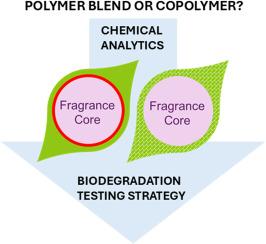证据权重分析方法:了解合成聚合物的化学组成,以帮助解释生物降解结果
IF 8.1
2区 环境科学与生态学
Q1 ENVIRONMENTAL SCIENCES
引用次数: 0
摘要
2023年,欧盟委员会发布了一项突破性的限制,禁止使用合成不溶性聚合物微粒(即微塑料),其中包括香精微胶囊,尽管它对微塑料的贡献很小。该限制为微塑料法规设定了标准,其中包括首次对符合证明生物降解性的特定规则的微颗粒进行豁免。在这一限制的豁免中,要求聚合物和聚合物“混合物”的所有成分在特定的测试方法下是可生物降解的。然而,该限制并没有提供明确的指导来区分这种“混合物”。在本研究中,以香精微胶囊为例,介绍了一种严格的纯化方法和一套分析技术,如FT-IR、SEC、GC、光谱学、氨基酸(LC)和可再生碳分析(MS),以证据权重(WOE)方法为手段,提供“混合”与“非混合”的清晰和区分。生物降解研究遵循经合组织310的规定,由欧盟委员会确定聚合物的生物降解性。在一个例子中,通过多异氰酸酯和明胶的界面聚合制备的香精微胶囊,纯化壁的生物降解率为83%,被总结为“混合物”;不同层的可生物降解的生物聚合物外壳和不可生物降解的聚脲壳。在另一个例子中,在聚异氰酸酯和明胶之间开发了一种新的预聚工艺,形成了一种“非混合”共聚物,尽管与第一种微胶囊具有相似的起始材料、生物降解结果和形态。本研究强调了WOE用于验证聚合物组成以避免假阳性生物降解性结论的必要性。这种方法可以扩展到评估任何复杂的,不溶性聚合物材料的结构。本文章由计算机程序翻译,如有差异,请以英文原文为准。

A weight of evidence analytical approach: Understanding chemical composition of synthetic polymers to aid in the interpretation of biodegradation results
In 2023, the European Commission published a ground-breaking restriction on the use of synthetic insoluble polymer microparticles (i.e., microplastics) that included fragrance microcapsules, despite its low contribution to the microplastic pool. Setting the bar for microplastic regulations, the restriction included a first-of-their-kind exemption for microparticles that met specified rules for proving biodegradability. Among the exemption to this restriction called for the polymer and all components of the polymer “blend” to be biodegradable, under specific testing methods. However, the restriction did not provide clear guidance to distinguish this “blend.” In the present study, examples of fragrance microcapsules were used to introduce a rigorous purification method and a suite of analytical techniques such as FT-IR, SEC, GC, spectroscopy, amino acid (LC) and renewable carbon analysis (MS) in a weight of evidence (WOE) approach as means to provide clarity and differentiation of a “blend” vs a “non-blend”. Biodegradation studies followed the OECD 310 specified by the European Commission for concluding polymer biodegradability. In one example, the fragrance microcapsule prepared through interfacial polymerization of polyisocyanate and gelatin, with 83 % biodegradation of the purified wall, was concluded as a “blend”; distinct layers of biodegradable biopolymer shell and a non-biodegradable polyurea shell. In another example, a new prepolymer process was developed between the polyisocyanate and gelatin to form a “non-blend” co-polymer, despite having similar starting materials, biodegradation results and morphologies versus the first microcapsule. This study highlights the necessity of the WOE for validating polymer composition to avoid false positive biodegradability conclusions. This approach may be extended to assessing the structure of any complex, insoluble polymeric material.
求助全文
通过发布文献求助,成功后即可免费获取论文全文。
去求助
来源期刊

Chemosphere
环境科学-环境科学
CiteScore
15.80
自引率
8.00%
发文量
4975
审稿时长
3.4 months
期刊介绍:
Chemosphere, being an international multidisciplinary journal, is dedicated to publishing original communications and review articles on chemicals in the environment. The scope covers a wide range of topics, including the identification, quantification, behavior, fate, toxicology, treatment, and remediation of chemicals in the bio-, hydro-, litho-, and atmosphere, ensuring the broad dissemination of research in this field.
 求助内容:
求助内容: 应助结果提醒方式:
应助结果提醒方式:


